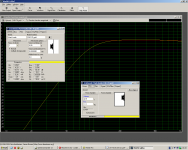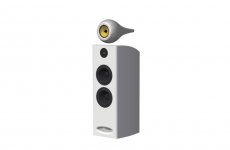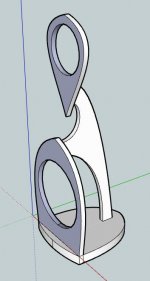Great mind...I was looking around and began considering this exact configuration! Nice that someone has already done it! It does look very funky 😎
With this size bowls, after subtracting the volumes due to the connecting ring, the vent, the components and the driver I got around 2.8L.Sims show that this driver in the ~4L enclosure these bowls create should play to 59Hz (-3dB), which on paper seems reasonable. Does the bass sound lacking?
This volume is half way between the "ideal volume" calculated from the manufacturer specs and the one from my measurements.
It's not easy to measure low frequencies, but the F3 is more like 75-80Hz, for sure not 59Hz, so yes some low bass are missing...
If you glue the 2 bowls together it won't be a sphere, it will have a "UFO kind of shape".I am probably being naive, but why can't the bowls simply be glued together to make a sphere? Why was a connecting ring required? Are they not the exact same diameter or flat around the tops, or is it just to make it more spherical, less squashed looking? What was the reason to sand them so heavily too, just for painting? I'd also like to flush mount the drivers, would there be enough material left to do this?
Did I sand them a lot?
The thickness is only 8mm, so flush mounting would not be possible, unless you add material inside...
I am not really sure how to answer those questions as I usually tame the driver by the successive tries until my ears are satisfied by the sound and my brain by the measurement...Also, in general with these spherical designs, are there any additional considerations? Surely a sphere creates a single strong internal resonance, is it completely tamed by damping material? Also, I can't model the baffle effects, I know this profile is supposed to be "good" but what does it mean in terms of baffle step correction? Does placing one of these designs near a wall mess up the response badly?
I haven't tried placing them really close to the wall...
Not sure this has been answered yet but I have a couple of FE107e that I'd like to try this out on. I may have another source for some larger salad bowls. Would someone mind modelling what they ideal dimensions of the sphere would be for these drivers?
Thanks
Chris
Thanks
Chris
Not sure this has been answered yet but I have a couple of FE107e that I'd like to try this out on. I may have another source for some larger salad bowls. Would someone mind modelling what they ideal dimensions of the sphere would be for these drivers?
Thanks
Chris
Well, I'm too lazy to actually model it for you (it pretty easy to do if you care to try). However off of the top of my heap I would guess around 2-3 liters if you want to use it in a two way design with a helper woofer.
Joe
Just got back from Ikea. The 28cm bowls are full hemispheres (except for the base) so no need for a ring. Measured at 4.5l which matches calculated 9.1
The 20cm bowls did appear to be flared at the rim, but I didn't examine them too close as didn't want those.
Sitting on my shelf now, 28cm looks BIG for desk monitors.
The 20cm bowls did appear to be flared at the rim, but I didn't examine them too close as didn't want those.
Sitting on my shelf now, 28cm looks BIG for desk monitors.
Small or Big?
Hello
I would like to build my first Speakers. I am still reading about the laws of Acoustics, therefore I am not quite sure about my project:
I will build spherical loudspeakers by combining the CHR-70 Driver with the Ikea "Blanda Salad Bowls". The CHR-70 seems to me a good choice as that broadband driver got good reviews on this forum, looks really nice and is not that expensive. It is also a versatile driver that fits in a whole range of different boxes. (That may be important just in case I mess something up or the resonances in that sphere are too extreme.)
WinIDS Alpha Pro suggests a capacity for the closed box of 6.75 liter.
The Blanda Salad Bowl (wall thickness ca. 1 cm) comes in two different sizes:
a.) External diameter: 28cm -> Capacity approx. 9 liter
b.) External diameter: 20cm -> Capacity approx. 3 liter
The net capacity of the 28 cm sphere is
9 liter of the untouched spere
- 0,5 liter CHR-70 approx.
- 0,062 liter spherical cap (a slice - regarding the inner diameter - of 1.25cm will be cut off. The capacity of the cap is small, it could in this case probably be ignored)
=8.43 liter
===========
If I do the same math for the smaller sphere (hight of inner cap: 1.51 cm -> 0.061 liter) I get a net capacity of 2.44 liter.
Now my questions about deviations:
1.) According to my calculations the 28cm sphere fits better to the CHR-70. The box should have 6.75 liter, in reality it will have 8.43 liter. Does the difference matter?
2.) If I would fit the driver - ignoring all the calculations - into the smaller box of 2.44 liter, will the result be horrible?
Thanks for your answers.
Hello
I would like to build my first Speakers. I am still reading about the laws of Acoustics, therefore I am not quite sure about my project:
I will build spherical loudspeakers by combining the CHR-70 Driver with the Ikea "Blanda Salad Bowls". The CHR-70 seems to me a good choice as that broadband driver got good reviews on this forum, looks really nice and is not that expensive. It is also a versatile driver that fits in a whole range of different boxes. (That may be important just in case I mess something up or the resonances in that sphere are too extreme.)
WinIDS Alpha Pro suggests a capacity for the closed box of 6.75 liter.
The Blanda Salad Bowl (wall thickness ca. 1 cm) comes in two different sizes:
a.) External diameter: 28cm -> Capacity approx. 9 liter
b.) External diameter: 20cm -> Capacity approx. 3 liter
The net capacity of the 28 cm sphere is
9 liter of the untouched spere
- 0,5 liter CHR-70 approx.
- 0,062 liter spherical cap (a slice - regarding the inner diameter - of 1.25cm will be cut off. The capacity of the cap is small, it could in this case probably be ignored)
=8.43 liter
===========
If I do the same math for the smaller sphere (hight of inner cap: 1.51 cm -> 0.061 liter) I get a net capacity of 2.44 liter.
Now my questions about deviations:
1.) According to my calculations the 28cm sphere fits better to the CHR-70. The box should have 6.75 liter, in reality it will have 8.43 liter. Does the difference matter?
2.) If I would fit the driver - ignoring all the calculations - into the smaller box of 2.44 liter, will the result be horrible?
Thanks for your answers.
Attachments
I really like this idea, using Ikea stuff.
What would be great is if i can get my hands on a "water droplet" shape for behind half a bowl.
I love the water droplet shape B&W uses with some of their speakers (Nautilus and 800 series come to mind). Anyone know what can be used to create such a water droplet shape?
They could be turned on a wood lathe. I've been working on a project with a teardrop mid housing. I'm going to turn one to make a molding and then cast them with Jesmonite as used in the Celestion Kingston speaker. Though to get it hollow is quite complex and requires another turned component which has to be able to be taken out the mold once set.
Still needs a little thought.
Attachments
That would be cool. (Im trying to do one with waveguide tweeters).
The OP of this thread just explained his method.
http://www.diyaudio.com/forums/multi-way/167091-wild-2way-design-my-old-man.html
so why not use an Ikea bowl then add maybe "fins" to it making the shape of that tweeter. The use his technique of wrapping fabric around it then more fabric soaked in fibre glass stuff (whateve he useds.
Im still looking for Bowls that are 16" wide so I can put a waveguide in one. Of course now I could just use a small box and create fins.....somes like fun 😀
The OP of this thread just explained his method.
http://www.diyaudio.com/forums/multi-way/167091-wild-2way-design-my-old-man.html
so why not use an Ikea bowl then add maybe "fins" to it making the shape of that tweeter. The use his technique of wrapping fabric around it then more fabric soaked in fibre glass stuff (whateve he useds.
Im still looking for Bowls that are 16" wide so I can put a waveguide in one. Of course now I could just use a small box and create fins.....somes like fun 😀
Last edited:
Guys... any shape can be created with the right technique.. sure it takes time to perfect... but anything is possible... I do all this with a Jigsaw and table router and a pancake compressor..
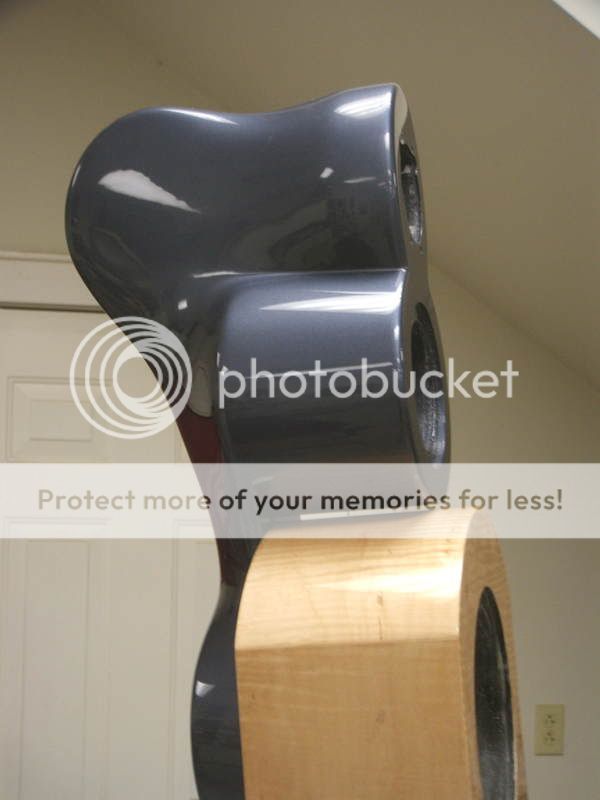


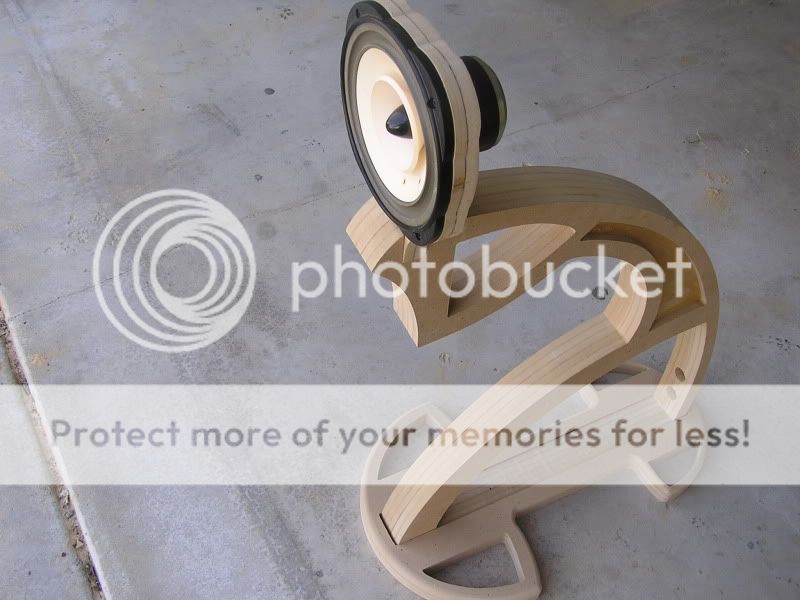




Hey Randy, if you will make me a set of those lovely nude driver stands, I will EnaBL your Lowthers for you and apply tuned Ground Controls.
Bud
Bud
Thanks... and sorry for Hijacking.... but those look like a drop in the bucket to make 😀
Wow, those are beautiful. I had this crazy idea for a dipole design in my head, but this is far beyond my construction skills.
WinIDS Alpha Pro suggests a capacity for the closed box of 6.75 liter.
=8.43 liter
Once you get above a certain size, boxes need to get a lot bigger to make a bit of difference. I usually target 5.5-7 litre. If you are worried that it is too large you can fit some blocks to use up volume and break up the internal resonance.
dave
I will EnaBL your Lowthers for you and apply tuned Ground Controls.
Okay, can someone explain that to a noob like me...Is that some sort of XO improvement?
ODG Doug, I am not sure you want to know! Well, maybe you do, but this is the wrong thread. In short it is a surface treatment for drivers that eliminates the tendency that they have to not emit a flat, coherent wave of energy into the air. Also disperses to one degree or another, resonance nodes, provides from 30 to 60 db down in coherent information, below the typical 40 db down and can be used to alter the phase relationship between the portion of FR that is phase minimum and the portion that is not, without materially changing the FR relationship. Very difficult to find in objective testing, though there is some evidence but appallingly evident in any sort of A / B tests, DBT or sighted, run to date.
Here is a short list of threads and forums you can dig through if you wish to.
Bud
Here is a short list of threads and forums you can dig through if you wish to.
Bud
Attachments
Cool, I just wanted a summary. I did some searching after I asked in this thread.
Thanks for the list of threads!
Thanks for the list of threads!
Won't the spherical shape of the enclosure mitigate against emitting a flat, coherent wave of energy?
spheres are the best baffle shapes, they have the best diffraction.
http://sound.westhost.com/bafflestep.htm
http://www.trueaudio.com/st_diff1.htm
http://sound.westhost.com/bafflestep.htm
http://www.trueaudio.com/st_diff1.htm
Last edited:
spheres are the best baffle shapes, they have the best diffraction.
They have the least edge diffraction and the smoothest step-loss diffraction... Except for the tear-drop shape exemplified by the B&Ws...
dave
- Home
- Loudspeakers
- Multi-Way
- Ikea spherical speakers, first build done.
